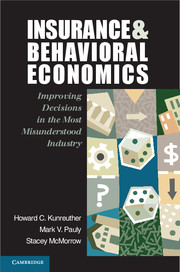Book contents
- Frontmatter
- Contents
- Preface
- Acknowledgments
- Part I Contrasting Ideal and Real Worlds of Insurance
- Part II Understanding Consumer and Insurer Behavior
- 5 Real-World Complications
- 6 Why People Do or Do Not Demand Insurance
- 7 Demand Anomalies
- 8 Descriptive Models of Insurance Supply
- 9 Anomalies on the Supply Side
- Part III The Future of Insurance
- Notes
- Glossary
- Bibliography
- Author Index
- Subject Index
8 - Descriptive Models of Insurance Supply
Published online by Cambridge University Press: 05 February 2013
- Frontmatter
- Contents
- Preface
- Acknowledgments
- Part I Contrasting Ideal and Real Worlds of Insurance
- Part II Understanding Consumer and Insurer Behavior
- 5 Real-World Complications
- 6 Why People Do or Do Not Demand Insurance
- 7 Demand Anomalies
- 8 Descriptive Models of Insurance Supply
- 9 Anomalies on the Supply Side
- Part III The Future of Insurance
- Notes
- Glossary
- Bibliography
- Author Index
- Subject Index
Summary
The benchmark model of supply assumes that competitive insurance firms know the loss probabilities and outcomes of the risks they are insuring against and base their premiums on this information. Furthermore, they are able to effortlessly change their premiums to reflect updates in their estimates of the risk. Insurance firms have access to the capital markets (at competitive interest rates) for any needed funds, even after experiencing a large loss. Investors who supply capital to insurers hold diversified portfolios. Losses are independent of one another, so that the law of large numbers minimizes the likelihood of an unexpectedly large total loss and makes it very unlikely an insurer will have to declare insolvency.
In that ideal world, insurance firms are also assumed to have accurate information on the risks of their customers and choose actions that maximize their expected profits. Under this model, firms should be willing to supply virtually any amount of insurance that buyers are likely to find attractive. The premiums they would charge are just high enough to cover their expected claims, including loading costs, which yield a rate of return on capital that investors could have earned elsewhere in the private market. The supply curve of insurance would be virtually horizontal because insurance uses only a tiny fraction of the global capital pool. In other words, the price of coverage should be largely unaffected by variations in the demand for insurance coverage or insurer demand for additional capital.
- Type
- Chapter
- Information
- Insurance and Behavioral EconomicsImproving Decisions in the Most Misunderstood Industry, pp. 145 - 161Publisher: Cambridge University PressPrint publication year: 2013
- 1
- Cited by



